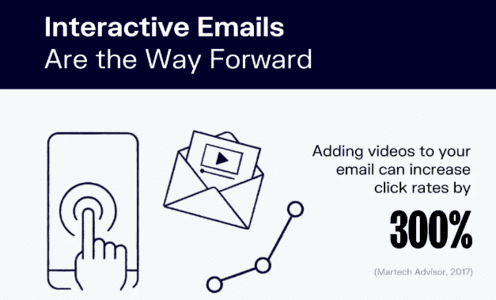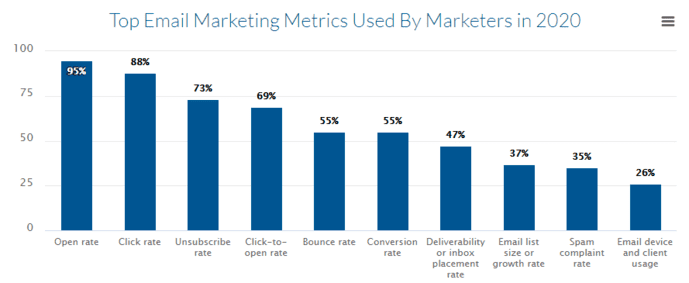Email marketing has the potential to increase the revenue by 4400%. For every one dollar spent, there’s a return of $44.
These facts have been repeated so many times that the numbers now seem to be carved on our memory. Say email marketing to a digital marketer and expect them to picture the number 44 on the canvas of their mind. The most important question, however, is: how many firms are making even one-fourth of the return, mentioned above, by investing a single dollar? And how many are crossing that magic number ‘44’?
If you want to answer only the second question and that too ‘loudly and proudly’, follow the 7 directives of email marketing to boost your ROI potential.
1. Create interactive emails
In other words, include functional elements inviting your users to interact with the content by tapping, swiping, clicking, or simply watching. A GIF or illustration can be used as an interactive feature, as can a quiz or a countdown timer.
You’ll be surprised to know that consumers welcome the move of including interactivity; marketers, on the other hand, are hesitant.

“While 91% of customers desire interactive content, just 17% of marketers deliver it,” Megan Moller, Litmus’ director of content marketing, stated. “This could be a squandered opportunity, as competition for subscribers’ attention is at an all-time high, and marketers claim that adding interactivity increases click-through rates by 200%.”
2. Leverage Email Marketing Metrics
Email analytics is a data-driven method of determining how subscribers interact with an email campaign using a set of metrics and KPIs. Marketers may optimize their email marketing campaigns by evaluating quantitative and qualitative aspects of user engagement, behavioral pattern, content impact, and so on, based on the huge amount of data gathered via analytics.

Source: FinancesOnline
All of this data enables for greater segmentation of subscribers (covered next), who are then interacted with in a more tailored way, resulting in improved customer acquisition and retention.
3. Segment your email lists
Revenue increases by 760% when campaigns are segmented. So, if you send the identical message to your whole email list every time you send a message, you’re not only missing out on a great opportunity but also squandering resources. Your list should be divided and broken down into as many separate portions as feasible. You must segment based on what works for you, from purchase history to order frequency and any other major piece of data relevant to your organization. The sooner you recognize that your email recipients don’t want the same thing, the sooner you’ll be able to send them emails that are tailored to their specific needs.
4. Automate your emails
Email automation is a powerful marketing automation tool that allows you to send the correct message to the correct people at the correct time using automated processes and workflows. It’s ideal for lead nurturing and, ultimately, driving sales from new and existing customers.
Automated email marketing, with proper segmentation and personalization, can do wonders for a business, allowing the marketing campaign to scale significantly. The goal is to send a short message with clear CTAs (calls to action) that encourage the receiver to click the link.
5. Write email copies with finesse
No matter how heavily you invest on automation, segmentation, or analytics, a badly written email copy would spoil the entire game. That’s why, it’s mandatory to write effective email copies with finesse.
To master the art of email copywriting, you don’t need to be a professional writer. All you have to do is come up with a few catchy subject lines that aren’t too long. Use practical language and easy directions to write informative copy. And always include one CTA every email to offer recipients a clear notion of what to do after they’ve read it.
6. Write email copies with sensitivity
Customers seek to be valued and that’s where loyalty comes from. It’s not just about the financial transaction, but establishing relationships. Subscribers are interested in your brand and want to learn more about your company and offerings. However, if you provide them news or material that they find irrelevant on a regular basis, it won’t be long before they unsubscribe.
Companies who provide personalized services – as well as bespoke content – will stand out from the crowd, capturing their clients’ attention and maintaining that all-important customer relationships. Yes, you want to make a profit from your goods. You want to spread the word about your company. To create a successful campaign, you must first understand the person making the purchase and their relationship to your product and brand.
7. Test your emails before dispatch
One of the proven ways to improve your emails and make them more productive in the long term is to test them before dispatching. The goal of A/B testing is to find out which features perform best for your target demographic, firmographic, and technographic.
Check all of the primary email components. Whether the length and wordings in your subject line is appropriate, how are the copies organized? By length or by content type? Check the CTA buttons and links. And last but not least, determine what the best time to send a newsletter is?
What Next?
Email marketing provides all of the tools a company needs to acquire and convert verified leads, but you must still devise a viable strategy and provide content that appeals to your target audience.
We gave you 7 directives to improve your email marketing ROI in this post, and we believe you’ll apply all of them to make your marketing more efficient.


